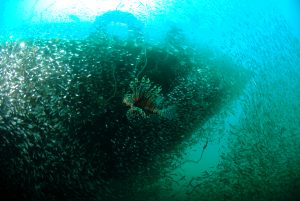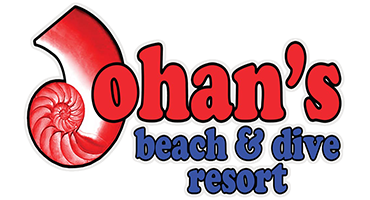LCU (LCT) Subic Dive Site
Type of Site: Ship wreck
Depth range: 10-21 meters (35-75 feet)
Length: 119 feet plus surrounding reef
Skill Levels: Open Water. Advance Open Water
Current: Generally calm
Visibility: 5-15 meters
Average Dive Time Recreational Diver: 45-60 minutes
Mooring Line: Attached to Winch on hull, Port side aft
Nitrox:
Dive Site:

LCU Ramp
The LCU sits on the edge of a reef in Triboa Bay. The Stern is about 10 meters deep while the open ramp is at about 21 meters. The most common profile is to start at the down line then move forward along the port side following the top of the wreck. At the bow, Open water divers can cross the bow to the starboard side and follow that aft. Advance divers can drop to the ramp then continue along the starboard. The ramp has a very good coverage of sea fans and an unusual school of lionfish. There are more than a dozen lionfish in this area and they seem to hunt together. This is uncommon behavior for this species of fish as they are normally seen solitary. The stern has a large number of juvenile fish.
The cargo deck can be visited by all skill levels and there are a few swim through. Wreck divers have a few limited penetrations and the site is often used as the first dive of a wreck course.
Ship:
The LCU, Landing Craft Utility was a very versatile amphibious craft in the early years of WWII. Operated from  tenders or cargo ships the LCU would be put into the water and loaded out of range of any shore defenses. It would then deliver it cargo of men and equipment onto the beach. However during WWII, the LCU did not really exist, it was a term that was applied to a number of different types of amphibious crafts. A specific LCU did not appear until after WWII. The wreck in Triboa bay seems to be a LCT(6). The Landing Craft Tank was used to land troops and equipment on shore. The LCT was often carried fully loaded on the main deck of a Landing Ship Tank (LST). While the LST approached a landing site, the LCT could be off loaded providing a more rapid deployment of assets. After the war the department of navy did develop a LCU class of craft and many of the LCT were designated to LCU’s MK6s were redesignated as Utility Landing Ship LSU in 1949 and redesignated Landing Craft Utility LCU, 15 April 1956.
tenders or cargo ships the LCU would be put into the water and loaded out of range of any shore defenses. It would then deliver it cargo of men and equipment onto the beach. However during WWII, the LCU did not really exist, it was a term that was applied to a number of different types of amphibious crafts. A specific LCU did not appear until after WWII. The wreck in Triboa bay seems to be a LCT(6). The Landing Craft Tank was used to land troops and equipment on shore. The LCT was often carried fully loaded on the main deck of a Landing Ship Tank (LST). While the LST approached a landing site, the LCT could be off loaded providing a more rapid deployment of assets. After the war the department of navy did develop a LCU class of craft and many of the LCT were designated to LCU’s MK6s were redesignated as Utility Landing Ship LSU in 1949 and redesignated Landing Craft Utility LCU, 15 April 1956.
Military Specifications: LCT(6)
Displacement 143 to 160 t.(lt), 309 to 320 t.(fl)
Length 119′ 1″ ovl.
Beam 32′ 8″
Draft 5′ (max)
Speed 10 kts.
Range 700 nautical miles at 7 kts.
Complement 14
Cargo Capacity 150 short tons
Armament 2 single 20mm AA gun mounts, 4 .50 cal. machine guns
Armor 20lbs wheelhouse, 10lbs gun shield
Propulsion 3 Grey Marine Diesels, 3 propellers, Shaft horsepower 225 per shaft





